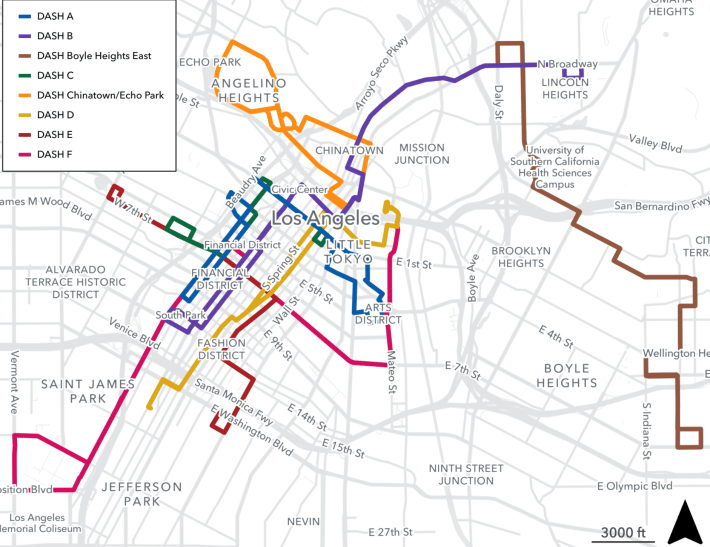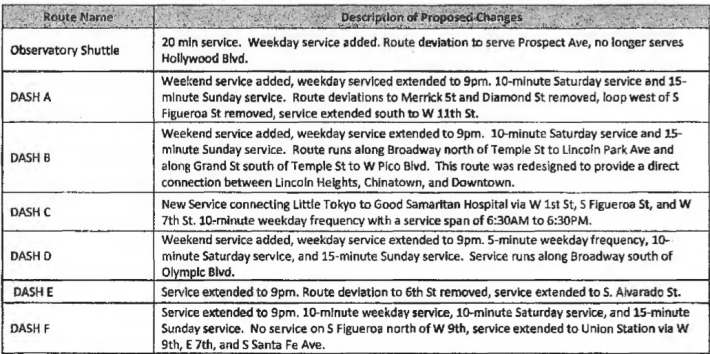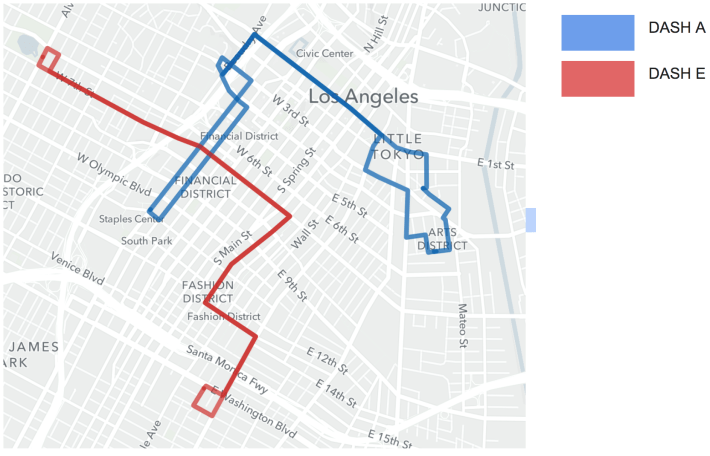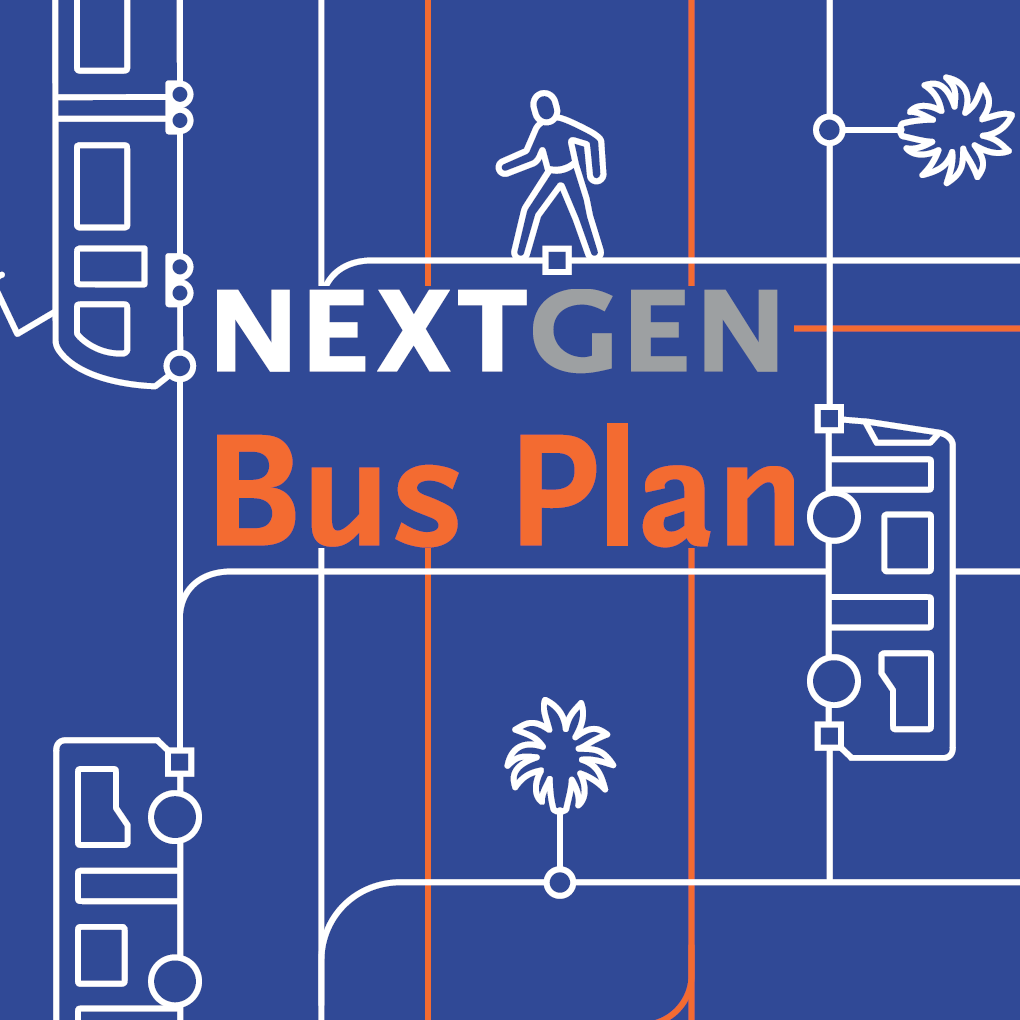Today, I will relate some follow-up to my proposal for Metro route 51 NextGen changes, how upcoming NextGen changes are looking, and some of the challenges NextGen faces.
I promoted my route 51 proposal at three Metro meetings: the January Consumer Advisory Council (page 6), the January Board meeting (at 4:33:00) and the February Westside/Central Service Council (at 1:43:40). At the Service Council meeting Joe Forgiarini, Senior Director, Service Performance & Analysis for Metro responded as reflected in the official minutes (page 6):
Mr. Forgiarini replied that staff recently met with the Los Angeles Dept. of Transportation (LADOT) on the suggestion and to check on their plans for restructuring DASH service. LADOT has some alternate plans for Line A which would not be consistent with Mr. Gabbard’s proposal, which was why LADOT selected Line E for extension. He suggested that Mr. Gabbard may want to check in with LADOT on their planned changes. Line 51/52 will continue serving its current route until further notice; it would not be moved off that route until DASH was providing alternative service on 7th St.
I realized the alternate plans Forgiarini spoke of were the ones that the Downtown News covered in this May 2018 article.


Colin Sweeney, Public Information Director at LADOT, not only clarified the situation with Metro route 51 and Downtown DASH E but shared exciting news on the aforementioned Downtown DASH restructuring along with the new DASH routes mentioned in the recently released 2021-2023 Strategic Plan Update:
All downtown DASH updates will be implemented by early July 1. New community routes for Canoga Park, Boyle Heights, Watts, Pacoima, and Sylmar will be implemented by early 2022. These changes, as well as upcoming added service and new Community DASH routes, are the implementation of the LADOT Transit Service Analysis, adopted by the City Council in 2018.
Relative to the Metro Route 51 changes, DASH E will now extend west to Alvarado (it currently turns around at Witmer). DASH A will now go down Flower St towards L.A. Live, rather than heading west along 7th St to Witmer as it does now.
Sweeney later caveated, that the “target date is July 1 but an official launch is still to be determined based on driver availability to meet the demands of the expansion.”

Given Forgiarini’s commitment that the route 51 change would not occur until DASH has their changes in place, the third and final NextGen service change in December 2021 is most likely when the 51 truncation at Figueroa is implemented.
And what is the status of NextGen?
As I noted previously, in December the first (of three) round of NextGen service changes was deliberately less ambitious. It was also not quite the whole planned NextGen frequent service network, due to Metro service cuts under COVID.
The Regional Updates presented at the March and April Service Council meetings indicates only approximately 25 comments had been received. Concerns focused on:
- Lines cancelled
- Stops discontinued
- Removal of Metro Rapid service
The reaction to the changes to be implemented June 27, 2021 will be a better indication of what the response of riders and the general public is to NextGen. We will have our first preview of those changes at the presentations to be made at the May or June Service Council meetings.
Meanwhile Metro ridership is up: weekdays 3.5 percent, Saturdays 8.8 percent, and Sundays 0.6 percent (week ending 3/20/2021 compared to week ending 12/12/2020). According to some line-by-line analysis, by February several high-ridership lines had already rebounded past two-thirds of their pre-COVID ridership levels.
There have been concerns expressed by some advocates about reports of crowding. The percentage of trips with maximum loads above 75 percent seated load are 1.2 percent on weekdays, 4.7 percent on Saturdays, and 1.5 percent on Sundays. [Load factor is the percentage of the seats on board that are occupied.]
An explanation of the 75 percent seated load target was offered by Mr. Forgiarini at the February Westside/Central Service Council meeting as reflected in the minutes:
It originated from an assessment of Metro’s operating capacity and ridership. That target was set to commit to a realistic scenario of what service Metro would be able to provide matched to ridership levels, rather than setting a lower maximum load threshold that the available operator workforce wouldn’t be able to meet.
One bit of good news is that extra service is to be added starting April 12:
- 47 extra weekday trips (Lines 2, 4, 10, 14, 16, 20, 30, 33, 204, 251, 534, 704, 720, 733)
- 86 extra Saturday trips (Lines 2, 16, 18, 20, 28, 51, 53, 60, 66, 78, 108, 180, 200, 204, 207, 224, 232, 251, 534, 720, 754)
- 48 extra Sunday trips (Lines 18, 28, 40, 51, 66, 81, 204, 207, 260, 704, 754)
In other developments, Torrance Transit is well along with its takeover this summer of the western half of Metro’s line 130 (Artesia Station to the Redondo Beach Pier via South Bay Galleria) as its line 13. No word yet if/when Long Beach Transit takes over the eastern half as NextGen proposes.
Amidst all this whirl of activity it is easy to miss what actually is going on.
A primary intent of NextGen is to reverse the trend toward declining ridership. NextGen does this by concentrating resources in the urban core, with corridors therein running frequent service. Service is further sped up by eliminating bus stops and adding improvements like bus lanes. All this works together to make transit more appealing/competitive. Metro focuses on the core routes, where, as one NextGen report noted, 53 percent of today’s bus riders use one of these top 25 corridors (called tier 1).
While beefing up that core service, Metro also cancels or hands off lower ridership lines in the periphery. This continues a trend reaching back decades where Metro hands off these lines to be run by municipal bus agencies (the most significant example of that is the Foothill Transit Zone gradually since 1988 assuming all service east of El Monte formerly operated by RTD and its successor Metro) whose cost per revenue service hour is lower and better suited for marginal lines.
These are steps toward repurposing the urban core to put transit first. Facilitating this will be implementing round one and two (pp.5-6) of a region-wide network of bus rapid transit, along with bus priority lanes in downtown Los Angeles and other areas - with the next bus lanes opening on Alvarado Street (7th Street to Sunset).
Meeting the challenges of the future calls for leaders with vision and a willingness to take risks.
Metro CEO Phil Washington passes the torch to incoming CEO Stephanie Wiggins at a critical juncture for NextGen. Wiggins exemplary past experience at Metro leads me to expect more continuity than change. Also on the horizon at this juncture, is the June/November 2022 L.A. City mayoral election. Whoever becomes the next mayor of Los Angeles will have a huge say in NextGen implementation as a de facto regional leader. We in the advocacy community must work to ensure those priorities are addressed by the candidates during the campaign. And thereafter hold them accountable.
As we emerge out of the darkness of the pandemic, let us move forward and build on the beginning NextGen offers.
_______
Dana Gabbard is a longtime transit rider, treasurer of Southern California Transit Advocates (SoCaTa), and a 2011 Streetsblog Streetsie Award winner. For more than a decade, he has written articles for Streetsblog Los Angeles.
The author thanks Joe Forgiarini and Dolores Ramos of Metro and Colin Sweeney of LADOT for their invaluable assistance in researching this post.







